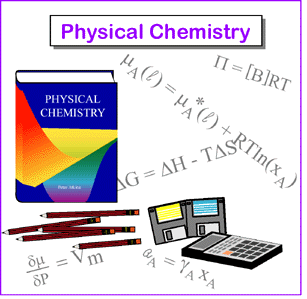DR. SURAJIT RAKSHIT
SRakshitLabrotary

+91 95645 06457

OVERVIEW OF TEACHING COURSES
Knowledge for Every Level

UNDERGRADUATE COURSE
CHB 201: Physical Chemistry
Thermodynamics: Thermodynamic quantities (w, q, ΔU and ΔH) for isothermal and adiabatic reversible expansion of ideal gases, variation of heat of reaction with temperature (Kirchhoff’s equation), Joule-Thomson effect, Joule-Thomson coefficient of real (van der Waals) gases, Second Law of Thermodynamics: entropy, entropy changes for an ideal gas, entropy changes at constant pressure and volume, entropy change in spontaneous processes, physical significance of entropy, Carnot cycle, free energy and maximum work functions, conditions for spontaneous changes and equilibrium, Maxwell relations, Gibbs-Helmholtz equation, van’t Hoff equation, reaction isotherm.
CHB 301: Physical Chemistry
Electrochemistry: Migration of ions: transference number and their determination (Hittorf method), molar and equivalent conductances and their measurements, Kohlrausch law of independent migration of ions, ionic mobilities, conductance measurements and applications to conductometric titrations, acid dissociation constant and solubility product determination.
Free energy change and emf of cells, Nernst equation, single electrode potentials, reference electrodes (SHE, calomel, silver-silver chloride electrodes), emf measurements, potentiometric titrations (acid – base, redox), buffer solutions, pH determination using quinhydrone and glass electrodes, concentration cells, liquid junction potential, acid-base indicators, indicator constant.
Phase Equilibria: Thermodynamics of phase transition, Clapeyron-Clausius equation, phase rule, phase diagrams of one-component (water) and two component (phenol-water & Pb-Ag) systems, distribution law, application to cases for dissociation and association, determination of equilibrium constant (KI + I2 = KI3).
Solid State: Crystal lattices, space lattice, unit cell, crystal systems, law of rational indices, Miller indices, Bragg’s equation, crystal structure of NaCl, graphite and diamond, Schottky and Frankel defects.
CHB 505: Nuclear Chemistry
Radio chemistry: Probing by isotopes, preparation of radioisotopes, radiochemical principles in use of tracers, some typical applications: chemical, physicochemical and analytical applications, age determination.
Radiation Chemistry: Interaction of nuclear radiations with matter- charged particle, neutrons and gamma rays. Radiolysis of water and aqueous solutions, radiation dosimetry.
CHB 604: Physical Chemistry
Molecular Spectroscopy: Region of electromagnetic spectrum, emission and absorption spectra, signal to noise ratio and resolving power, width and intensity of spectral transitions, pure rotational spectra, diatomic rigid rotor molecules, effect of isotope substitution, vibrational and vibration- rotational spectra of diatomic molecules, harmonic oscillator-rigid rotor approximation, anharmonicity effect, normal modes of vibration, infrared spectra of linear and bent AB2 molecules, electronic spectra of diatomic molecules, vibrational structure, Franck-Condon principle.
Nuclear Magnetic Resonance Spectroscopy: Introduction, chemical shifts, spin-spin splitting, relaxation times.

GRADUATE COURSE
CHM 205: Chemical Binding
Molecular structure: Born-Oppenheimer approximation, molecular orbital treatment for H2+, MO treatment of homo- and hetero nuclear diatomic molecules, Hückel MO treatment of simple and conjugated polyenes.
CHM 301: Molecular Spectroscopy (Core Paper)
Magnetic resonance: A review of spin angular momentum, basic principles and relaxation times, intensity of NMR signals, electronic shielding, NMR in liquids: chemical shifts, spin-spin couplings, NMR spectra of AX, A3X and AB systems. ESR of hydrogen, first order hyperfine energies, ESR of organic radicals in solution.
FT-NMR: Rotating frame of reference, effect of RF pulses, FID, Multipulse operation, measurement of T1 by inversion recovery method, spin echo and measurement of T2, 2-D NMR, NMR hardware.

